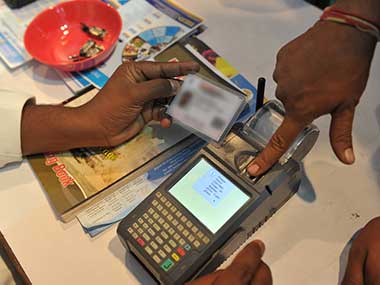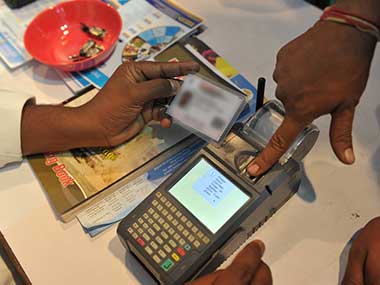Editor’s Note: This is the second in a two-part series analysing the judgment of the Supreme Court of India in KS Puttaswamy versus Union of India, upholding the validity of the Aadhaar project. In stark contrast to the opinion of the majority is Justice DY Chandrachud’s dissent in the Puttaswamy v. Union of India case. The dissent first examined whether the Aadhaar Bill’s passage into the Aadhaar Act as a Money Bill was valid, and next examined whether the provisions of the Aadhaar Act themselves were valid. This was the appropriate order to analyse the issues because the exercise of testing the Aadhaar Act’s validity on substance is premised on the idea that the Bill validly became an Act. Bypassing the Rajya Sabha as a Money Bill The dissent holds that the question whether the Speaker correctly certified the Aadhaar Bill as a Money Bill can be examined in a court because the Speaker’s decision had to abide by Article 110 of the Constitution of India – which is a rule of substance, not mere procedure. The violation of rules of substance cannot be shielded from the court’s scrutiny in the way “procedural irregularities” are by Article 122 of the Constitution. Article 110 permitted a Bill to be a Money Bill if it “contains only provisions” dealing with matters listed in the grounds in Article 110(1)(a) – (f). This meant the Aadhaar Bill could not contain even a single provision that did not deal with matters listed in Article 110(1). Those provisions in the Aadhaar Bill that did not deal with appropriations from or receipt of money on account of the Consolidated Fund of India, could not be severed from the provisions that did. So there could be no question of partially upholding the Aadhaar Bill as a valid Money Bill; the whole Bill’s passage as a Money Bill failed on constitutionality ( page 154, dissent ). [caption id=“attachment_5280721” align=“alignleft” width=“380”]  Representational image. AFP[/caption] The majority sidestepped this problem, proceeding on the assumption that reading down provisions to make them seem related to expenses from the Consolidated Fund, would bring the provisions in line with Article 110(1). They explained their approach stating that Section 7’s targeted delivery of subsidies dealt with expenses from the Consolidated Fund of India, while the rest of the Act, once read down, facilitated the delivery of subsidies or were somehow incidental to the larger Section 7 goal. However, Justice Chandrachud shows this cannot be the case. Every single provision of the Aadhaar Act would have had to deal with expenses or receipts from the Consolidated Fund of India to be valid as a Money Bill, as demanded by the text of Article 110(1). If some provisions were only incidental to or facilitated the Section 7 purpose, then these provisions were incidental to the content of the Bill ( page 151, dissent ). Matters incidental to the content of the Bill — such as enrolment and authentication rules, UIDAI machinery, etc. — could not be validly brought under Article 110(1)(g), which permitted only those “incidental” matters ancillary to the matters listed in (a) to (f). Needless to say, the grounds in Article 110(1)(a) to (f) do not concern themselves with targeted subsidies or Aadhaar; they are a list of enumerated grounds which, if exclusively formed the content of a Bill, could be the only way to a valid Money Bill. Why was it so important that the Speaker’s decision be open to scrutiny by the court? To preserve the role of the Rajya Sabha as the Upper House of Parliament, Justice Chandrachud reasoned. Apart from representing the interests of the states, the Rajya Sabha, being an indirectly elected house that is never dissolved, is a multi-partisan check on the majoritarian power of the Lok Sabha. If certification as a Money Bill could never be reviewed by the court, then the Rajya Sabha could conveniently be bypassed whenever it appeared inconvenient for the Bill’s passage. No constitutional functionary could hold such unbridled power that their decisions could weaken bicameralism and thus federalism, the dissent reasoned ( page 148-9, dissent ). Constitutionality of the Act The government justified mandatory Aadhaar-based biometric authentication relying on Section 7, to claim that its main purpose was to prevent leaks in subsidy delivery. This was a legitimate interest, of course. However, the existence of a legitimate state interest was not enough, because the ends do not justify the means under a democratic Constitution. The government also had to show that its chosen means were proportionate to its ends: first, the means must be rationally related to the ends of the State, second, the means must not infringe rights to a greater extent than necessary, and third, the State must show that no alternate means could be used that were less infringing of one’s privacy. This was the dissent’s second key departure from the majority: reliance on the proportionality standard to test the substance of the Aadhaar Act, where the majority chose to “balance” the competing rights. Noting that “benefits” and “services” were widely defined under the Act, Justice Chandrachud held that Section 7 extended to the full gamut of State facilities enjoyed by an Indian resident, ranging from road transport to civic amenities, health care and even tax rebates – all of which were in some manner funded from the Consolidated Fund of India. This is a crucial recognition by the dissent: the compulsory nature of Aadhaar based biometric identification under Section 7 was broad enough to cover ‘every aspect of the cycle of life from delivery to deliverance’ ( page 339-340, dissent ). Section 7 was thus vague, ambiguous, and arbitrary ( page 344, dissent ). Worse still, the burden of proof was on the government to show that less intrusive means to prevent leakages in subsidy delivery were absent, which the government had failed to show. This made Section 7 a disproportionate incursion into the privacy rights of citizens, way beyond what was necessary to prevent the leakage of subsidy in distribution ( page 351-52, dissent ). Sidestepping this issue as well, the majority upheld the mandatory nature of Section 7, by interpreting “services” and “benefits” to mean services and benefits that were similar to “subsidies” ( page 390-1, majority opinion ). This, of course, forces us to ask: what exactly is the distinction between subsidies and other government benefits or services? A tax rebate could be a subsidy too, as could scholarships by the Ministry of Human Resource Development. The other conditions laid down by the majority — that the benefit or service had to be backed by law, and funded from the Consolidated Fund of India — are also of no help in understanding how a subsidy is different from a benefit or service. The only clue provided by the majority lies in its suggestion that subsidies had to be seen in their context: as meant for the “poor” and “marginalized section of society”, and not in abstract, as meant for kings, corporations or parliamentarians ( page 337, 390, 438, majority opinion ). Does this imply that programmes with mandatory Aadhaar based biometric authentication are proportionate restrictions on the right to privacy, only if they target the marginalised? This cannot be a constitutional outcome, as it allows a different standard of privacy protections depending on how well to do one is. As for the question of alternative less-intrusive means, the majority cursorily held that even the petitioners “could not suggest any such method”, ignoring that the burden to show less intrusive means was on the State. My identification is not my identity The majority and dissenting opinions seemingly exist on parallel planes on all counts. They are not merely different interpretations of the law. Reading them side by side makes one wonder if both opinions can possibly be true and valid under the same Constitution in the same republic. One way to understand the complete dissonance between the opinions is to reckon with the absence of a shared premise between them. The conceptual premise of the dissenting opinion is that identity cannot be folded into identification. Identification is the proof of one’s identity. Each person has the right to determine for herself how she will identify in others’ eyes. The right to recognition of one’s identity is recognised globally in human rights instruments. Thus, recognition of one’s identity could not be made contingent on showing just one type of identification a la the Aadhaar number. On the contrary, the majority holds at multiple points that the Aadhaar empowers persons from marginalised and underprivileged sections of society, by “giving such individuals their unique identity” ( page 350, 377, majority opinion ). That statement alone is telling. One question we will reckon with more often, in the wake of the National Register of Citizens and the upholding of the Aadhaar project is: if a unique identification number gives us our identities, will the deletion of the number obliterate us in the eyes of the State? Also Read **Aadhaar verdict: SC's majority judgment lacks consistency in logic and reasoning, turns constitutional analysis on its head**
The government justified mandatory Aadhaar-based biometric authentication relying on Section 7, to claim that its main purpose was to prevent leaks in subsidy delivery.
Advertisement
End of Article


)

)
)
)
)
)
)
)
)



